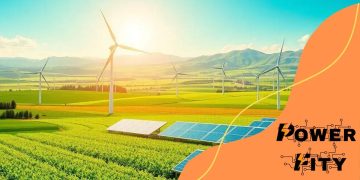Green energy investments through bonds for a sustainable future

Investing in green energy bonds allows individuals and institutions to support renewable energy projects while potentially earning attractive financial returns in a growing market driven by sustainability initiatives.
Green energy investments through bonds are gaining traction as individuals and institutions seek sustainable options to diversify their portfolios. Have you ever thought about how your investments could contribute to a cleaner planet? This article delves into the ins and outs of harnessing bonds for renewable energy initiatives.
Understanding green energy investments
Understanding green energy investments is essential for anyone looking to contribute to a sustainable future while also boosting their financial portfolio. These investments focus on technologies that harness renewable resources, making them both environmentally friendly and potentially lucrative.
What Are Green Energy Investments?
Green energy investments are allocations of funds into projects or companies that aim to generate energy through sustainable means. This includes solar, wind, hydroelectric, and geothermal energy sources. By investing in these areas, individuals and organizations can support the transition to a low-carbon economy.
Benefits of Green Energy Investments
- Environmental Impact: Investing in green energy helps reduce greenhouse gas emissions.
- Financial Returns: Many green projects show promising long-term returns.
- Energy Independence: These investments can lead to more energy self-sufficiency.
- Government Incentives: Various tax credits and subsidies make these investments more attractive.
As the world moves toward cleaner energy solutions, understanding these investments becomes vital. A growing number of investors are recognizing that green energy is not just a trend; it’s the future of sustainable growth.
Moreover, many companies in this sector are innovating rapidly. They are developing new technologies that enhance energy efficiency and reduce costs. By getting involved now, you can be part of a transformative movement that reshapes how energy is produced and consumed.
The role of bonds in funding renewable energy
The role of bonds in funding renewable energy is significant, as they provide the necessary capital for projects that aim to generate clean energy. Many governments and corporations utilize bonds to secure financing for their green initiatives.
Types of Bonds for Renewable Energy
There are various types of bonds specifically designed to support renewable energy projects. These include green bonds, municipal bonds, and corporate bonds. Each type serves a unique purpose, catering to different investors and projects.
- Green Bonds: These bonds are exclusively used to finance environmentally friendly projects.
- Municipal Bonds: Local governments often issue these bonds to fund public projects, including renewable energy installations.
- Corporate Bonds: Companies issue these to raise funds for their own sustainable energy projects.
As the market for renewable energy grows, the demand for bonds to fund these initiatives increases. Investors are increasingly drawn to bonds that not only offer returns but also contribute to a sustainable future. This shift reflects the broader trend of integrating environmental, social, and governance (ESG) criteria into investment decisions.
Investing in bonds for renewable energy can also provide stability. These bonds often come with lower risks compared to stocks, making them an attractive option for cautious investors. With advancements in technology and the push for cleaner energy, the outlook for bonds in this sector remains promising.
Benefits of investing in green energy bonds

Investing in green energy bonds offers numerous benefits that attract both individual and institutional investors. These bonds not only provide financial returns but also play a critical role in promoting sustainable energy solutions.
Financial Returns
One of the primary advantages of green energy bonds is the potential for solid financial returns. Many projects funded through these bonds generate substantial income as they operate, often leading to reliable interest payments for investors. Additionally, as the demand for renewable energy increases, the value of these bonds can appreciate over time.
Supporting Sustainability
By investing in green energy bonds, investors actively contribute to the fight against climate change. These investments finance projects that reduce carbon emissions and promote cleaner air and water. This dual benefit of earning returns while supporting the environment makes green energy bonds particularly appealing to eco-conscious investors.
- Alignment with Values: Investors can align their portfolios with their sustainability values.
- Long-Term Stability: Many green projects offer stable, long-term returns, reducing overall portfolio risk.
- Government Support: These bonds often come with various government incentives, making them more attractive.
- Growing Market: As more people recognize the importance of renewable energy, the market for these bonds continues to expand.
Moreover, the growing public and corporate focus on environmental, social, and governance (ESG) criteria enhances the appeal of green energy investments. These factors contribute to the increasing confidence in green energy bonds, fostering a healthier investment ecosystem.
In conclusion, the benefits of investing in green energy bonds extend beyond just financial gain. They allow investors to make a meaningful impact while also providing opportunities for solid returns. This unique intersection of profit and purpose is what makes green energy bonds a compelling option in today’s investment landscape.
How to choose green energy bonds wisely
Choosing green energy bonds wisely can be a rewarding endeavor. The right investments not only support sustainable projects but also provide financial benefits. Every investor should consider a few key factors when making their decisions.
Researching Projects
Start by researching the projects that the bonds fund. Look for initiatives with clear goals, solid management, and proven track records. Understanding the specifics of what you are investing in is crucial. This knowledge helps you evaluate whether the projects align with your values and investment strategy.
Evaluating Credit Ratings
Next, consider the credit ratings of the bonds. These ratings provide insight into the risk associated with the bonds. Higher-rated bonds generally indicate a lower risk of default, making them more appealing to conservative investors. It is important to balance your desire for return with the risks involved.
- Look for ratings: Check independent agencies that rate bonds.
- Assess issuer credibility: Research the organizations issuing the bonds.
- Understand market conditions: Economic trends can affect performance.
Moreover, determine the bond’s maturity date. Shorter-term bonds may offer less risk, while longer-term bonds can yield higher returns depending on the project’s success. Matching the maturity of the bonds with your investment timeline ensures that your investments fit your financial goals.
Finally, keep an eye on fees and expenses. Some bonds may come with higher management fees that can eat into your returns. Always read the fine print before investing. Transparent fee structures are a positive sign of a reputable investment.
Future outlook for green energy investments
The future outlook for green energy investments is incredibly promising. As global awareness of climate change continues to rise, more investors are turning toward sustainable solutions. With advancements in technology and government policies favoring renewable energy, this sector is poised for significant growth.
Market Growth Trends
In recent years, the green energy market has experienced remarkable growth. Reports indicate that investments in renewable energy sources such as solar, wind, and hydroelectric power are expected to surge. As more countries commit to reducing carbon emissions, the demand for green energy will only increase.
Government Initiatives
Governments around the world are implementing initiatives to promote green energy investments. Incentives such as tax credits and grants are becoming common. These policies not only encourage new projects but also attract more investors. Understanding these government strategies is crucial for anyone interested in the market.
- Subsidies for renewables: Many governments offer financial support for renewable energy projects.
- Standards and regulations: Regulations favoring clean energy can enhance investment opportunities.
- International agreements: Global agreements, like the Paris Agreement, push countries to invest more in green energy.
Moreover, innovations in technology are making renewable energy sources more efficient and affordable. These advancements are reducing costs and improving energy production. As technology continues to evolve, the viability of green energy will increase, attracting a broader range of investors.
The rise of socially responsible investing also contributes to the growth of green energy investments. Many investors are looking for opportunities that align with their values. This trend is creating more demand for bonds and stocks in this sector, making it a lucrative area for those seeking to invest in the future of energy.
FAQ – Frequently Asked Questions about Green Energy Investments
What are green energy bonds?
Green energy bonds are investment securities issued specifically to finance projects that generate energy from renewable sources, like solar and wind.
Why should I invest in green energy?
Investing in green energy supports sustainable initiatives while offering potential for good financial returns due to the growing demand for renewable energy.
How can government policies influence green energy investments?
Governments often provide incentives such as tax credits and grants to encourage investments in renewable energy projects, making them more attractive to investors.
What factors should I consider when choosing green energy bonds?
Consider the project’s credibility, credit ratings, maturity dates, and any associated fees to make informed investment decisions in green energy bonds.





